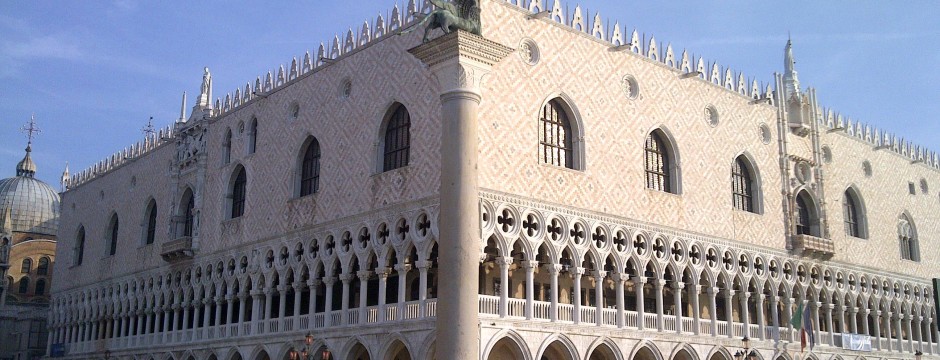St. Mark’s Square was more than just an open public space or a piazza where the most important buildings stood and public events were taking place as in any other major Italian city. During the entire length of Venice as an independent state, for about eight centuries, the Piazza as the locals call it, was also a civic forum where Venetian run their public parades. Inheriting the distinct Byzantine taste for pump and pageantry Venetians transformed those parades in the highest display of civic honor ever seen in Europe and into a major tourist attraction as well. Napoleon’s conquest of Venice brought an abrupt end to that time opening the next season for the square, the tourist era still running in the present time.
The tour will start first with a description of all the buildings in Sain’t Mark Square and their functions including the Old and the New Procuracies, Naopoleon’s Wing and the Marciana Library. A special attention will be given to the Clock Tower where at every hour two statues will hit the bell with their hammers while mobile figures will show the time. You’ll also know about the history of the Square and the great events that use to took place here before it became a tourist icon with the first ‘tourist invasion’ of the 19th century.
Entering Saint’s Mark Basilica is a time travel experience, you’ll go back to the 6th century in Costantinople and see how one of the earliest greatest Christian churches look like in the age of Emperor Justinian. He ordered the building of the Church of the Holy Apostles in his capital city. That glorious building will be later used as a model for Venice’s present Saint Mark’s church which is then a dazzling example of Byzantine architecture.
The first church was built in the 9th century as a chapel where to enshrine the relics of the Evangelist Mark brought from Alexandria by two Venetian merchants to endow the new city with status and respect.
Rebuilt in the 11th century and decorated during the following four hundred years, the present building strikes all visitors for the extensive ceiling surface entirely covered by mosaics half of that made of shining gold. As you look with admiration to the heavenly figures the guide will describe to you the main subjects shown and the techniques used to create this gigantic ‘puzzle’. The other source of marvel in san Marco church relies in the marble decoration of the lower part of the building up to 42, the largest display of that material in one single building in Europe. The church is also the best place to talk about the early days of Venice and the events that led to the beginning of it as a true city.
According to the duration of the tour and your preferences it is possible to view also the Golden Altarpiece an amazing Byzantine masterpiece made of 255 enamels and almost two thousand gems.
San Marco was in its days a national church ruled by the state in the person of the Duke no suprise then that the Ducal Palace is next door to the temple. The palace was at first a castle surrounded by water and the Duke was an absolute leader who substituted the role of the Byzantine military commander when the Eastern soldiers withdrew in the 8th century.
The palace was rebuilt two more times: first in the 12th century when the position of the Duke was downsized to that of a figurehead and Venice become a Republican State. And the second one, bringing the palace to the present state between the 14th and the 16th centuries and this is the building you’ll visit.
The palace is divided in three main sections, the Duke’s abode where the Chief of State lived when he was in office, the State Rooms where the main government bodies had their seat and the Prisons, the main detention facility in town.
The Prison was connected to the palace by the famous Bridge of Sighs transformed in a tourist icon by the British visitors of the 19th century. To convey the power, wealth and prestige of the State, Venetians spent with no restraint in decorating the palace calling the best artists of its days. All visitors will be impressed by the large gilded coffered ceilings and the lavish decoration of most rooms.
The building also houses some world class paintings by leading artists of its days the most known are Veronese and Tintoretto. But the interest in visiting the Ducal Palace also relies on the chance to get in deep knowledge of the institutions and government bodies of the first European republic ever where all officers were elected and on for a short term.

